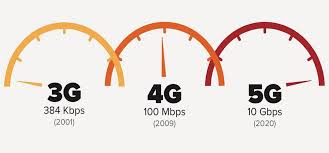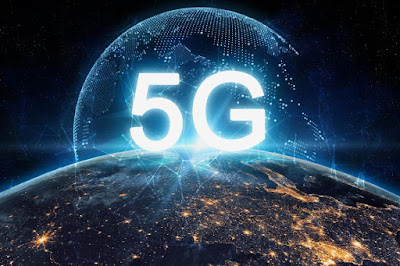Everything You Need To Know About 5G
5G is the 5th generation mobile network. It will take a much larger role than previous generations.
 |
| Fifth Generation Wireless Technology (5G) |
What is 5G?
The fifth generation of cellular technology, 5G, is the next great leap in speed for wireless devices. This speed includes both the rate mobile users can download data to their devices and the latency, or lag, they experience between sending and receiving information.
5G aims to deliver data rates that are 10 to 100 times faster than current 4G networks. Users should expect to see download speeds on the order of gigabits per second (Gb/s), much greater than the tens of megabits per second (Mb/s) speeds of 4G.
What 5g can do?
5G will elevate the mobile network to not only interconnect people, but also interconnect and control machines, objects, and devices. It will deliver new levels of performance and efficiency that will empower new user experiences and connect new industries. 5G will deliver multi-Gbps peak rates, ultra-low latency, massive capacity, and more uniform user experience.
What are the other generations of mobile networks?
- 1G delivered analog voice.
- 2G introduced digital voice (e.g., CDMA).
- 3G brought mobile data (e.g., CDMA2000).
What is the difference between 4G and 5G?
There are several differences between 4G vs 5G:
 |
| 3G VS 4G VS 5G |
What makes 5G so different from 4G?
Simply said, 5G is widely believed to be smarter, faster and more efficient than 4G. It promises mobile data speeds that far outstrip the fastest home broadband network currently available to consumers. With speeds of up to 100 gigabits per second, 5G is set to be as much as 100 times faster than 4G.
Low latency is a key differentiator between 4G and 5G. Latency is the time that passes from the moment information is sent from a device until it can be used by the receiver. Reduced latency means that you’d be able to use your mobile device connection as a replacement for your cable modem and Wi-Fi. Additionally, you’d be able to download and upload files quickly and easily, without having to worry about the network or phone suddenly crashing. You’d also be able to watch a 4K video almost straight away without having to experience any buffering time.
Which country is using 5G?
The top countries with 5G include South Korea, the United Kingdom, Germany, and the United States. Since the first commercial launches of the fifth generation of mobile networks in late 2018, these four countries have emerged as leaders because multiple companies in these countries have deployed networks and are selling compatible devices. Countries including Switzerland and Finland are up and comers in 5G development, as they have limited deployment.
When 5G will launch in India?
5G services in India are going to be launched as late as 2021 or in 2022. TRAI Secretary said in a recent CII event that "The telecom sector will move to 5G by 2022 and access to digital platform will become highly advanced in the next five years".
Will 4G mobile support 5G?
Today's 4G LTE networks are more than fast enough for all the video and music streaming you want to do on your phone. ... These phones will also work on 4G LTE networks when they aren't on 5G. Your current phone won't be able to work on 5G
 |
| Fifth Generation Wireless Technology (5G) |
Can a 4G phone be upgraded to 5G?
No, you'll need a new phone. If you have a 3G or 4G phone it will still work on 5G plans, but you'll only get 3G or 4G speeds.
Will 5G replace Wifi?
While 5G is still some time away for consumers, one of the most obvious applications of this technology will be to replace your home broadband service. ... Mika Skarp, CEO at Cloud Street, says: ""Yes, most certainly 5G will replace Ethernet, but it will do much, much more, and it needs to.Advantages of 5G?
Possible to provide a uniform, consistent and uninterrupted, connectivity across the world. Technology is able to gather all networks on one platform. 5G offers 10x decrease in latency, 100x traffic capacity 10x connection density, 3x spectrum efficiency, and 100x network efficiency.
Why is 5G dangerous?
Although 5G may improve our day to day lives, some consumers have voiced concern about potential health hazards. Many of these concerns are over 5G's use of the higher energy millimeter-wave radiation. ... It's ionizing radiation that is dangerous because it can break chemical bonds."Some 5G pundits contend that the new network generates radiofrequency radiation that can damage DNA and lead to cancer; cause oxidative damage that can cause premature aging; disrupt cell metabolism; and potentially lead to other diseases through the generation of stress proteins.
Comments
Post a Comment
Please do not enter any spam link in the comment box